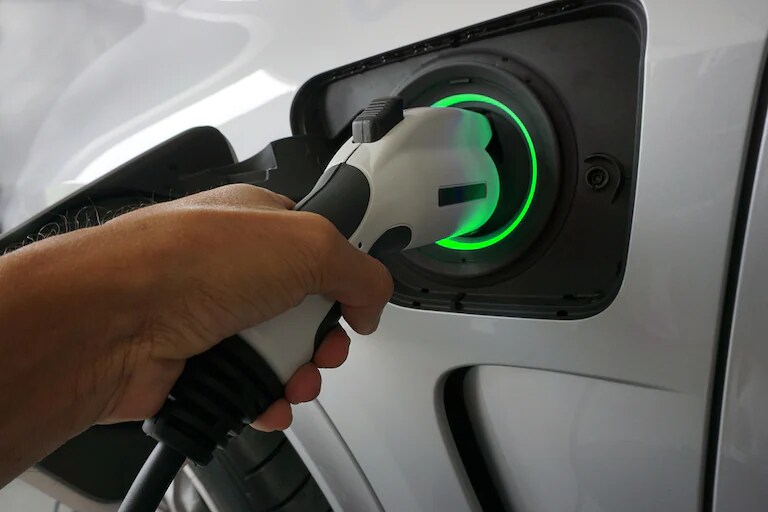Why Buy – Ford Electric/Hybrid Models
Which EV is Right for Me?
Benefits of Plugging In
96%
Owning an EV
Understanding Charging
Charging times vary depending of the type of charger used.
Level 1 chargers use a standard household outlet and charge about 2-5 miles of range per hour, making Level 1 a good choice for plugin hybrid vehicles but not battery electric vehicles.
Level 2 chargers can be installed at your home by a professional electrician and charge about 10-20 miles of range per hour. A good choice for any EV when charging overnight or all-day is possible.
Level 3 fast chargers are the most efficient and can be found at commercial locations. Level 3 can charge about 60-80 miles of range in about 20 minutes, making it a good choice for any EV when a quick charge is needed on the go.

Charging from Home
For plugin hybrid vehicles a standard outlet (Level 1) will be enough for overnight charging. For battery electric vehicles, a Level 2 charger will require professional installation by a licensed electrician. If you live in an apartment or condo, consider talking with the property owner about installing a charger or use a nearby public charger. Talk to our sales staff to find out more about charging from home.

Battery Care
Most batteries will last between 100,000 and 200,000 miles when properly cared for. With battery technology continually advancing, that number will continue to increase. If you can keep your battery between 20% and 80% charged most days and avoid extremely hot temperatures, you can expect your maintenance to be minimal.

The Family of Ford Hybrid and Electric Vehicles
Ford hybrid and electric vehicles feature advanced fuel-saving technology. Whether they're operating in electric, gas mode or a combination of both, these vehicles optimize efficiency and simplicity. The plug-in hybrid vehicles can be recharged in under three hours using a 240-volt outlet. And now, there's an all-electric SUV in the family - meet the Mustang Mach-E
All-Electric Models
Mustang Mach-E: Experience sleek design, seamless technology and impressive range. The all-electric Mustang Mach-E was made for long drives, good vibes and torque-drenched exhilaration.
F-150 Lightning: F-series has been America’s best-selling truck for 44 years* for a reason. And now, it’s charging into the future with the all-new, all-electric 2022 Ford F-150 Lightning. It’s the first ever F-Series that’s gas free and offers more connected technology, an elevated driving experience and trusted Built Ford Tough capability.
**Based on 1977-2020 CY total sales.E-Transit: America’s best-selling van* is charging forward with the 2022 Ford E-Transit van. Available in Chassis Cab, Cutaway and Cargo Van models, it comes in 3 lengths and roof heights on Cargo Van. E-Transit offers versatility and access to the largest public charging network in North America. **
*Based on total U.S. reported sales (2019CY).**Based on original equipment manufacturers/automotive manufacturers that sell all-electric vehicles and have publicly announced charging networks. Department of Energy data used.
Hybrid & Plug-in Hybrid Models
Maverick: This is a pickup for pioneers. The first ever standard full hybrid truck in America starts at just $19,995 MSRP* — so you can get more bang for your budget.Escape Hybrid: 2022 Escape Titanium Hybrid. * Standard on all Hybrid models, the 2.5L I-4 Atkinson-cycle powertrain features an electronically controlled continuously variable transmission (eCVT) and a 96 kW electric motor. Also, the Escape Hybrid packages its liquid-cooled lithium-ion battery smartly outside of the vehicle cabin below the floor of the second-row seats, rather than occupying a significant portion of the cargo area. Models: SE Hybrid, SEL, Hybrid and Titanium Hybrid.
*2.5L Titanium Hybrid FWD/CVT. Range calculation based on 14.2-gallon tank and EPA-estimated rating of 41 combined mpg. Actual mileage and range will vary.
Escape Plug-In Hybrid: The 2022 Escape Plug-In Hybrid* model has a Level 1/Level 2 AC charging port. What’s more, the design of the 2022 Escape SUV allows for the battery to be stored underneath the vehicle, which frees up space in the cabin, offering plug-in customers more room with no humps from the battery. Three available models, SE Plug-in Hybrid, SEL Plug-in Hybrid and Titanium Plug-in Hybrid.
*Available at Ford EV-certified dealers only.F-150 Hybrid: Whether operating in electric mode, gas mode or a combination of both, the F-150® hybrid features advanced technology that optimizes power and performance. And like every F-150®, it’s Built Ford Tough,® with its available 3.5L PowerBoost™ full hybrid V6 engine putting out a commanding 430 horsepower and 570 lb.-ft. of torque. *,**
*Calculated via combined performance of the engine and electric motor(s) with peak battery power. The calculations utilize SAE J1349® engine results and Ford electric motor dyno testing. Your results may vary.
**Horsepower and torque are independent attributes and may not be achieved simultaneously.
Explorer Platinum Hybrid: The 2022 Ford Explorer is primed for modern-day exploration. Its adjustable interior offers space and comfort for the whole family. And it helps you make the most of every experience with connected technology and an athletic build that’s ready for whatever lies ahead.
Charging Stations Near Nick Nicholas Ford Inc
Common Questions
Other advantages of owning an EV include:
- Eligible EVs may also qualify for HOV lane access, which are normally restricted to vehicles with multiple passengers.
- Many electric companies offer lower rates based on the time of use. With EVs, you can save money by charging during off-peak times.
- If you're able to charge from work or home, there's usually no need to stop to refuel like you would in a gas-powered vehicle.
- EVs produce zero tail-pipe emissions resulting in cleaner air and better health.
This will vary depending on the local price of electricity and gas and where you are charging (at home or public charger), but most EV owners can expect to save on fuel cost. A recent Consumer Reports study found the “typical EV owner who does most of their fueling at home can expect to save an average of $800 to $1,000 a year on fueling costs over an equivalent gasoline-powered car.”
Source: Benjamin Preston. October 08, 2020. EVs Offer Big Savings Over Traditional Gas-Powered Cars.
https://www.consumerreports.org/hybrids-evs/evs-offer-big-savings-over-traditional-gas-powered-cars/A recent Consumer Reports study found “maintenance and repair costs for EVs are significantly lower over the life of the vehicle – about half – than for gasoline–powered vehicles, which require regular fluid changes and are more mechanically complex. The average dollar savings over the lifetime of the vehicle is about $4,600.”
Source: Benjamin Preston. October 08, 2020. EVs Offer Big Savings Over Traditional Gas-Powered Cars.
https://www.consumerreports.org/hybrids-evs/evs-offer-big-savings-over-traditional-gas-powered-cars/- Level 1 chargers use a standard household outlet and charge about 2-5 miles of range per hour, making Level 1 a good choice for plugin hybrid vehicles but not battery electric vehicles.
- Level 2 chargers can be installed at your home by a professional electrician and charge about 10-20 miles of range per hour. A good choice for any EV when charging overnight or all-day is possible.
- Level 3 fast chargers are the most efficient and can be found at commercial locations. Level 3 can charge about 60-80 miles of range in about 20 minutes, making it a good choice for any EV when a quick charge is needed on the go.
Ready to Shop?
How can we help?
* Indicates a required field